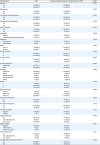1. Sankaranarayanan R, Thara S, Esmy PO, Basu P. Cervical cancer: screening and therapeutic perspectives. Med Princ Pract. 2008; 17:351–364.

2. Landoni F, Maneo A, Colombo A, Placa F, Milani R, Perego P, et al. Randomised study of radical surgery versus radiotherapy for stage Ib–IIa cervical cancer. Lancet. 1997; 350:535–540.

3. Zullo MA, Manci N, Angioli R, Muzii L, Panici PB. Vesical dysfunctions after radical hysterectomy for cervical cancer: a critical review. Crit Rev Oncol Hematol. 2003; 48:287–293.

4. Butler-Manuel SA, Summerville K, Ford A, Blake P, Riley AJ, Sultan AH, et al. Self-assessment of morbidity following radical hysterectomy for cervical cancer. J Obstet Gynaecol. 1999; 19:180–183.

5. Fujii S, Takakura K, Matsumura N, Higuchi T, Yura S, Mandai M, et al. Anatomic identification and functional outcomes of the nerve sparing Okabayashi radical hysterectomy. Gynecol Oncol. 2007; 107:4–13.

6. Kato T, Murakami G, Yabuki Y. A new perspective on nerve-sparing radical hysterectomy: nerve topography and over-preservation of the cardinal ligament. Jpn J Clin Oncol. 2003; 33:589–591.

7. Possover M, Stober S, Plaul K, Schneider A. Identification and preservation of the motoric innervation of the bladder in radical hysterectomy type III. Gynecol Oncol. 2000; 79:154–157.

8. Espino-Strebel EE, Luna JT, Domingo EJ. A comparison of the feasibility and safety of nerve-sparing radical hysterectomy with the conventional radical hysterectomy. Int J Gynecol Cancer. 2010; 20:1274–1283.

9. Pieterse QD, Ter Kuile MM, Deruiter MC, Trimbos JB, Kenter GG, Maas CP. Vaginal blood flow after radical hysterectomy with and without nerve sparing. A preliminary report. Int J Gynecol Cancer. 2008; 18:576–583.

10. Cibula D, Velechovska P, Slama J, Fischerova D, Pinkavova I, Pavlista D, et al. Late morbidity following nerve-sparing radical hysterectomy. Gynecol Oncol. 2010; 116:506–511.

11. Basaran D, Dusek L, Majek O, Cibula D. Oncological outcomes of nerve-sparing radical hysterectomy for cervical cancer: a systematic review. Ann Surg Oncol. 2015; 22:3033–3040.

12. Long Y, Yao DS, Pan XW, Ou TY. Clinical efficacy and safety of nerve-sparing radical hysterectomy for cervical cancer: a systematic review and meta-analysis. PLoS One. 2014; 9:e94116.

13. Charoenkwan K. A simplified technique for nerve-sparing type III radical hysterectomy: by reorganizing their surgical sequence, surgeons could more easily identify key nerves. Am J Obstet Gynecol. 2010; 203:600.e1–600.e6.
14. Charoenkwan K, Srisomboon J, Suprasert P, Tantipalakorn C, Kietpeerakool C. Nerve-sparing class III radical hysterectomy: a modified technique to spare the pelvic autonomic nerves without compromising radicality. Int J Gynecol Cancer. 2006; 16:1705–1712.

15. Jackson KS, Naik R. Pelvic floor dysfunction and radical hysterectomy. Int J Gynecol Cancer. 2006; 16:354–363.

16. Ralph G, Tamussino K, Lichtenegger W. Urological complications after radical abdominal hysterectomy for cervical cancer. Baillieres Clin Obstet Gynaecol. 1988; 2:943–952.
17. Trimbos JB, Maas CP, Deruiter MC, Peters AA, Kenter GG. A nerve-sparing radical hysterectomy: guidelines and feasibility in Western patients. Int J Gynecol Cancer. 2001; 11:180–186.

18. Querleu D, Cibula D, Abu-Rustum NR. 2017 update on the Querleu-Morrow classification of radical hysterectomy. Ann Surg Oncol. 2017; 24:3406–3412.

19. Rendón GJ, Echeverri L, Echeverri F, Sanz-Lomana CM, Ramirez PT, Pareja R. Outpatient laparoscopic nerve-sparing radical hysterectomy: a feasibility study and analysis of perioperative outcomes. Gynecol Oncol. 2016; 143:352–356.

20. Yang Y, Qin T, Zhang W, Wu Q, Yang A, Xu F. Laparoscopic nerve-sparing radical hysterectomy for bulky cervical cancer (>/=6 cm) after neoadjuvant chemotherapy: a multicenter prospective cohort study. Int J Surg. 2016; 34:35–40.
21. Kindermann G, Debus-Thiede G. Postoperative urological complications after radical surgery for cervical cancer. Baillieres Clin Obstet Gynaecol. 1988; 2:933–941.
22. Wells TH, Steed H, Capstick V, Schepanksy A, Hiltz M, Faught W. Suprapubic or urethral catheter: what is the optimal method of bladder drainage after radical hysterectomy? J Obstet Gynaecol Can. 2008; 30:1034–1038.

23. Covens A, Rosen B, Gibbons A, Osborne R, Murphy J, DePetrillo A, et al. Differences in the morbidity of radical hysterectomy between gynecological oncologists. Gynecol Oncol. 1993; 51:39–45.

24. van Gent MD, Romijn LM, van Santen KE, Trimbos JB, de Kroon CD. Nerve-sparing radical hysterectomy versus conventional radical hysterectomy in early-stage cervical cancer. A systematic review and meta-analysis of survival and quality of life. Maturitas. 2016; 94:30–38.

25. Cibula D, Slama J, Velechovska P, Fischerova D, Zikan M, Pinkavova I, et al. Factors affecting spontaneous voiding recovery after radical hysterectomy. Int J Gynecol Cancer. 2010; 20:685–690.







 PDF
PDF Citation
Citation Print
Print




 XML Download
XML Download